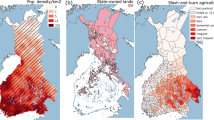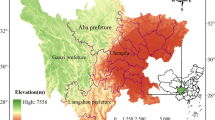Abstract
Human activities and natural processes over millennia have shaped the forest landscapes of European mountain ranges. In the Apennines, the second largest range in Italy, the post–World War II abandonment of traditional activities has led to forest expansion. Previous analyses of land use change related to forest landscape were performed for relatively small localities and used different sampling protocols. Consequently, a replicate landscape approach and a systematic sampling design were crucial for quantifying changes at the regional scale. We investigated land cover change and landscape configurational shifts comparing different slope exposures and altitudinal zones and discussed the main drivers affecting post-agricultural forest dynamics. We selected two paired study landscapes (North-East vs South-West) of 16 km2 for each of 10 sites located along the entire range. We applied object-based classification to aerial photography from 1954 and 2012, resulting in 40 land cover maps. We assessed (i) overall landscape changes by computing land cover transitions, (ii) landscape patterns through key metrics, and (iii) reforestation dynamics through multivariate statistics and binomial generalized linear models (GLMs). Apennine landscape mosaics experienced structural simplification at lower elevation due to tree establishment in abandoned pastures, but a diffuse fragmentation of historical grasslands at higher elevation due to development of woody vegetation patches beyond the forest-grassland ecotone. Forest expansion occurred more rapidly at lower elevations, on steeper slopes, and closer to existing forests and cultivated areas. A replicate landscape approach proved useful for quantifying changes to forest cover and landscape structure along complex gradients of topography and land use history, following a diffuse agro-pastoral abandonment.






Similar content being viewed by others
References
Abadie J, Dupouey J-L, Avon C, Rochel X, Tatoni T, Berges L (2017) Forest recovery since 1860 in a Mediterranean region: drivers and implications for land use and land cover spatial distribution. Landsc Ecol 33:289–305. https://doi.org/10.1007/s10980-017-0601-0
Améztegui A, Brotons L, Coll L (2010) Land-use changes as major drivers of mountain pine (Pinus uncinata Ram.) expansion in the Pyrenees. Glob Ecol Biogeogr 19:632–641. https://doi.org/10.1111/j.1466-8238.2010.00550.x
Assini S, Filipponi F, Zucca F (2014) Land cover changes in an abandoned agricultural land in the Northern Apennine (Italy) between 1954 and 2008: spatio-temporal dynamics. Plant Biosyst 149:807–817. https://doi.org/10.1080/11263504.2014.983202
Bakudila A, Fassio F, Sallustio L, Marchetti M, Munafò M, Ritano N (2015) I comuni e le comunità appenninici: evoluzione del territorio. Slowfood.it. Available online: http://www.slowfood.it/stati-generali-delle-comunita-dellappennino/
Bartón K (2017) MuMIn: multi-model inference. Package Version 1.40.0
Basualdo M, Huykman N, Volante JN, Paruelo JM, Piñeiro G (2018) Lost forever? Ecosystem functional changes occurring after agricultural abandonment and forest recovery in the semiarid Chaco forests. Sci Total Environ 650:1537–1546. https://doi.org/10.1016/j.scitotenv.2018.09.001
Benini L, Bandini V, Marazza D, Contin A (2010) Assessment of land use changes through an indicator-based approach: a case study from the Lamone river basin in Northern Italy. Ecol Indic 10:4–14. https://doi.org/10.1016/j.ecolind.2009.03.016
Bracchetti L, Carotenuto L, Catorci A (2012) Land-cover changes in a remote area of central Apennines (Italy) and management directions. Landsc Urban Plan 104:157–170. https://doi.org/10.1016/j.landurbplan.2011.09.005
Bugmann H, Gurung AB, Ewert F, Haeberli W, Guisan A, Fagre D, Kääb A (2007) Modeling the biophysical impacts of global change in mountain biosphere reserves. Mt Res Dev 27:66–77. https://doi.org/10.1659/0276-4741(2007)27[66:MTBIOG]2.0.CO;2
Burnham KP, Anderson DR (2002) Model selection and multimodel inference: a practical information-theoretic approach (2nd ed). Ecol Model 172:96–97. https://doi.org/10.1016/j.ecolmodel.2003.11.004.
Campagnaro T, Frate L, Carranza ML, Sitzia T (2017) Multi-scale analysis of alpine landscapes with different intensities of abandonment reveals similar spatial pattern changes: implications for habitat conservation. Ecol Indic 74:147–159. https://doi.org/10.1016/j.ecolind.2016.11.017
Chapman CA, Chapman LJ (1999) Forest restoration in abandoned agricultural land: a case study from East Africa. Conserv Biol 13:1301–1311. https://doi.org/10.1046/j.1523-1739.1999.98229.x
Chauchard S, Carcaillet C, Guibal F (2007) Patterns of land-use abandonment control tree-recruitment and forest dynamics in Mediterranean mountains. Ecosystems 10:936–948. https://doi.org/10.1007/s10021-007-9065-4
Cimini D, Tomao A, Mattioli W, Barbati A, Corona P (2013) Assessing impact of forest cover change dynamics on high nature value farmland in Mediterranean mountain landscape. ASR 37:29–37. https://doi.org/10.12899/ASR-771
Cousins SAO (2001) Analysis of land-cover transitions based on 17th and 18th century cadastral maps and aerial photographs. Landsc Ecol 16:41–54. https://doi.org/10.1023/A:1008108704358
De Aranzabal I, Schmitz MF, Aguilera P, Pineda FD (2008) Modelling of landscape changes derived from the dynamics of socio-ecological systems. A case of study in a semiarid Mediterranean landscape. Ecol Indic 8:672–685. https://doi.org/10.1016/j.ecolind.2007.11.003
Debussche M, Lepart J, Dervieux A (1999) Mediterranean landscape changes: evidence from old postcards. Glob Ecol Biogeogr 8:3–15. https://doi.org/10.1046/j.1365-2699.1999.00316.x
Endress BA, Chinea JD (2019) Landscape patterns of tropical forest recovery in the Republic of Palau. Biotropica 33:555–565. https://doi.org/10.1111/j.1744-7429.2001.tb00214.x
Falcucci A, Maiorano L, Boitani L (2007) Changes in land-use/land-cover patterns in Italy and their implications for biodiversity conservation. Landsc Ecol 22:617–631. https://doi.org/10.1007/s10980-006-9056-4
FAOSTAT (2010). Available online: http://faostat.fao.org
Fernández JBG, Mora MRG, Novo FG (2004) Vegetation dynamics of Mediterranean shrublands in former cultural landscape at Grazalema Mountains, South Spain. Plant Ecol 172:83–94. https://doi.org/10.1023/B:VEGE.0000026039.00969.7a
Flinn KM, Vellend M (2005) Recovery of forest plant communities in post-agricultural landscapes. Front Ecol Environ 3:243–250. https://doi.org/10.1890/1540-9295(2005)003[0243:ROFPCI]2.0.CO;2
Florentine SK, Westbrooke ME (2004) Restoration on abandoned tropical pasturelands - do we know enough? J Nat Conserv 12:85–94. https://doi.org/10.1016/j.jnc.2003.08.003
Foster DR, Motzkin G, Slater B (1998) Land-use history as long-term broad-scale disturbance: regional forest dynamics in central New England. Ecosystems 1:96–119. https://doi.org/10.1007/s100219900008
Garbarino M, Lingua E, Weisberg PJ, Bottero A, Meloni F, Motta R (2013) Land-use history and topographic gradients as driving factors of subalpine Larix decidua forests. Landsc Ecol 28:805–817. https://doi.org/10.1007/s10980-012-9792-6
Gartzia M, Alados CL, Perez-Cabello F (2014) Assessment of the effects of biophysical and anthropogenic factors on woody plant encroachment in dense and sparse mountain grasslands based on remote sensing data. Prog Phys Geogr 38:201–217. https://doi.org/10.1177/0309133314524429
Gartzia M, Pérez-Cabello F, Bueno CG, Alados CL (2016) Physiognomic and physiologic changes in mountain grasslands in response to environmental and anthropogenic factors. Appl Geogr 66:1–11. https://doi.org/10.1016/j.apgeog.2015.11.007
Geri F, Amici V, Rocchini D (2010a) Human activity impact on the heterogeneity of a Mediterranean landscape. Appl Geogr 30:370–379. https://doi.org/10.1016/j.apgeog.2009.10.006
Geri F, Rocchini D, Chiarucci A (2010b) Landscape metrics and topographical determinants of large-scale forest dynamics in a Mediterranean landscape. Landsc Urban Plan 95:46–53. https://doi.org/10.1016/j.landurbplan.2009.12.001
Gimmi U, Bürgi M, Stuber M (2008) Reconstructing anthropogenic disturbance regimes in forest ecosystems: a case study from the Swiss Rhone valley. Ecosystems 11:113–124. https://doi.org/10.1007/s10021-007-9111-2
ISPRA – Italian Institute for Environmental Protection and Research (n.d.) DTM 20x20 m, 2013. Available online: http://www.sinanet.isprambiente.it/it/sia-ispra/download-mais/dem20/view
ISTAT (1951) Annuario di statistiche demografiche vol. 33. Codice SBN: MIL0007941
ISTAT (2011) 15° Censimento generale della popolazione e delle abitazioni. Codice SBN: IST0008469
Jensen JR, Qiu F, Patterson K (2001) A neural network image interpretation system to extract rural and urban land use and land cover information from remote sensor data. Geocarto Int 16:19–28. https://doi.org/10.1080/10106040108542179
Körner C (2007) The use of “altitude” in ecological research. Trends Ecol Evol 22:569–574. https://doi.org/10.1016/j.tree.2007.09.006
Kuemmerle T, Chaskovskyy O, Knorn J, Radeloff VC, Kruhlov I, Keeton WS, Hostert P (2009) Forest cover change and illegal logging in the Ukrainian Carpathians in the transition period from 1988 to 2007. Remote Sens Environ 113:1194–1207. https://doi.org/10.1016/j.rse.2009.02.006
Lugo AE, Helmer E (2004) Emerging forests on abandoned land: Puerto Rico’s new forests. For Ecol Manag 190:145–161. https://doi.org/10.1016/j.foreco.2003.09.012
MacDonald D, Crabtree J, Wiesinger G, Dax T, Stamou M, Fleury P, Lazpita G, Gibon A (2000) Agricultural abandonment in mountain areas of Europe: environmental consequences and policy response. J Environ Manag 59:47–69. https://doi.org/10.1006/jema.1999.0335
Malandra F, Vitali A, Urbinati C, Garbarino M (2018) 70 years of land use/land cover changes in the Apennines (Italy): a meta-analysis. Forests 9:1–15. https://doi.org/10.3390/f9090551
Malavasi M, Carranza ML, Moravec D, Cutini M (2018) Reforestation dynamics after land abandonment: a trajectory analysis in Mediterranean mountain landscapes. Reg Environ Chang 18:2459–2469. https://doi.org/10.1007/s10113-018-1368-9
Mallinis G, Koutsias N, Arianoutsou M (2014) Monitoring land use/land cover transformations from 1945 to 2007 in two peri-urban mountainous areas of Athens metropolitan area, Greece. Sci Total Environ 490:262–278. https://doi.org/10.1016/j.scitotenv.2014.04.129
McGarigal K, Marks BJ (1994) FRAGSTATS: spatial pattern analysis program for quantifying landscapes structure. Gen Tech Rep PNW-GTR-351 US Dep Agric For Serv Pacific Northwest Res Station Portland, OR 97331:134. https://doi.org/10.2737/PNW-GTR-351
Metailié JP, Paegelow M (2005) Land abandonment and the spreading of the forest in the eastern French pyrenées in the nineteenth to twentieth. In: Mazzoleni S, di Pasquale G, Mulligan M, di Martino P and Rego F (ed) Recent dynamics of the Mediterranean vegetation and landscape, 2004 John Wiley & Sons, Ltd, pp 271–236
Nathan R, Muller-landau HC (2000) Spatial patterns of seed dispersal, their determinants and consequences for recruitment. Trends Ecol Evol 15:278–285. https://doi.org/10.1016/S0169-5347(00)01874-7
Naveh Z (1995) Interactions of landscapes and cultures. Landsc Urban Plan 32:43–54. https://doi.org/10.1016/0169-2046(94)00183-4
Niedrist G, Tasser E, Lüth C, Dalla Via J, Tappeiner U (2009) Plant diversity declines with recent land use changes in European Alps. Plant Ecol 202:195–210. https://doi.org/10.1007/s11258-008-9487-x
Palombo C, Chirici G, Marchetti M, Tognetti R (2013) Is land abandonment affecting forest dynamics at high elevation in Mediterranean mountains more than climate change? Plant Biosyst 147:1–11. https://doi.org/10.1080/11263504.2013.772081
Pelorosso R, Leone A, Boccia L (2009) Land cover and land use change in the Italian central Apennines: a comparison of assessment methods. Appl Geogr 29:35–48. https://doi.org/10.1016/j.apgeog.2008.07.003
Peroni P, Ferri F, Avena GC (2000) Temporal and spatial changes in a mountainous area of central Italy. J Veg Sci 11:505–514. https://doi.org/10.2307/3246580
Petanidou T, Kizos T, Soulakellis N (2008) Socioeconomic dimensions of changes in the agricultural landscape of the Mediterranean basin: a case study of the abandonment of cultivation terraces on Nisyros Island, Greece. Environ Manag 41:250–266. https://doi.org/10.1007/s00267-007-9054-6
Piermattei A, Lingua E, Urbinati C, Garbarino M (2016) Pinus nigra anthropogenic treelines in the central Apennines show common pattern of tree recruitment. Eur J For Res 135:1119–1130. https://doi.org/10.1007/s10342-016-0999-y
Plieninger T, Hui C, Gaertner M, Huntsinger L (2014) The impact of land abandonment on species richness and abundance in the Mediterranean basin: a meta-analysis. PLoS One 9(5):e98355. https://doi.org/10.1371/journal.pone.0098355
Queiroz C, Beilin R, Folke C, Lindborg R (2014) Farmland abandonment: threat or opportunity for biodiversity conservation? A global review. Front Ecol Environ 12(5):288–296. https://doi.org/10.1890/120348
R Development Core Team (2018) R: a language and environment for statistical computing. R Foundation for Statistical Computing, Vienna, Austria. ISBN 3-900051-07-0, URL: http://www.R-project.org.
Rey Benayas J (2007) Abandonment of agricultural land: an overview of drivers and consequences. CAB Rev. https://doi.org/10.1079/pavsnnr20072057
Riitters KH, O’Neill RV, Hunsaker CT, Wickham JD, Yankee DH, Timmins SP, Jones KB, Jackson BL (1995) A factor analysis of landscape pattern and structure metrics. Landsc Ecol 10:23–39. https://doi.org/10.1007/BF00158551
Rocchini D, Perry GLW, Salerno M, Maccherini S, Chiarucci A (2006) Landscape change and the dynamics of open formations in a natural reserve. Landsc Urban Plan 77:167–177. https://doi.org/10.1016/j.landurbplan.2005.02.008
Roura-Pascual N, Pons P, Etienne M, Lambert B (2005) Transformation of a rural landscape in the eastern Pyrenees between 1953 and 2000. Mt Res Dev 25:252–261. https://doi.org/10.1659/0276-4741(2005)025[0252:TOARLI]2.0.CO;2
Rudel TK, Coomes OT, Moran E, Achard F, Angelsen A, Xu J, Lambin E (2005) Forest transitions: towards a global understanding of land use change. Glob Environ Chang 15:23–31. https://doi.org/10.1016/j.gloenvcha.2004.11.001
Sitzia T, Semenzato P, Trentanovi G (2010) Natural reforestation is changing spatial patterns of rural mountain and hill landscapes: a global overview. For Ecol Manag 259:1354–1362. https://doi.org/10.1016/j.foreco.2010.01.048
Tarquini S, Vinci S, Favalli M, Doumaz F, Fornaciai A, Nannipieri L (2012) Release of a 10-m-resolution DEM for the Italian territory: comparison with global-coverage DEMs and anaglyph-mode exploration via the web. Comput Geosci 38:168–170. https://doi.org/10.1016/j.cageo.2011.04.018
Tasser E, Tappeiner U, Cernusca A (2005) Ecological effects of land-use changes in the European Alps. In: Huber UM, Bugmann HKM, Reasoner MA (eds) Global Change and Mountain Regions. Advances in Global Change Research, vol 23. Springer, Dordrecht, 23:409–420. https://doi.org/10.1007/1-4020-3508-X_41
Tischendorf L (2001) Can landscape indices predict ecological processes consistently? Landsc Ecol 16:235–254. https://doi.org/10.1023/A:1011112719782
Turner BL, Meyer WB, Skole DL (1994) Global land-use land-cover change - towards an integrated study. Ambio 23:91–95. https://doi.org/10.2307/4314168
Vacchiano G, Garbarino M, Lingua E, Motta R (2017) Forest dynamics and disturbance regimes in the Italian Apennines. For Ecol Manag 388:57–66. https://doi.org/10.1016/j.foreco.2016.10.033
Vitali A, Urbinati C, Weisberg PJ, Urza AK, Garbarino M (2017) Effects of natural and anthropogenic drivers on land-cover change and treeline dynamics in the Apennines (Italy). J Veg Sci 29:1–22. https://doi.org/10.1164/rccm.200806-848OC
Weisberg PJ, Shandra O, Becker ME (2013) Landscape influences on recent timberline shifts in the Carpathian Mountains: abiotic influences modulate effects of land-use change. Arct Antarct Alp Res 45:404–414. https://doi.org/10.1657/1938-4246-45.3.404
Acknowledgments
We wish to thank Fedele Maiorano and Francesca Lallo for their help in image analysis.
Funding
This research was partially financed by the Marche Polytechnic University through the project No. 123/2016 “Land use change in the Apennine mountain range: a multiscale analysis.”
Author information
Authors and Affiliations
Corresponding author
Additional information
Editor: Sarah Gergel.
Publisher’s note
Springer Nature remains neutral with regard to jurisdictional claims in published maps and institutional affiliations.
Electronic supplementary material
ESM 1
(DOCX 1195 kb)
Rights and permissions
About this article
Cite this article
Malandra, F., Vitali, A., Urbinati, C. et al. Patterns and drivers of forest landscape change in the Apennines range, Italy. Reg Environ Change 19, 1973–1985 (2019). https://doi.org/10.1007/s10113-019-01531-6
Received:
Accepted:
Published:
Issue Date:
DOI: https://doi.org/10.1007/s10113-019-01531-6




